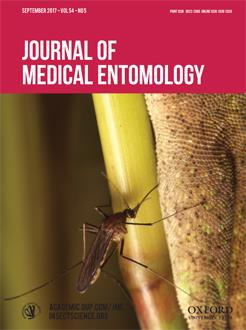The recently recognized Lyme disease spirochete, Borrelia mayonii, has been detected in host-seeking Ixodes scapularis Say ticks and is associated with human disease in the Upper Midwest. Although experimentally shown to be vector competent, studies have been lacking to determine the duration of time from attachment of a single B. mayonii-infected I. scapularis nymph to transmission of spirochetes to a host. If B. mayonii spirochetes were found to be transmitted within the first 24 h after tick attachment, in contrast to Borrelia burgdorferi spirochetes (>24 h), then current recommendations for tick checks and prompt tick removal as a way to prevent transmission of Lyme disease spirochetes would need to be amended. We therefore conducted a study to determine the probability of transmission of B. mayonii spirochetes from single infected nymphal I. scapularis ticks to susceptible experimental mouse hosts at three time points postattachment (24, 48, and 72 h) and for a complete feed (>72–96 h). No evidence of infection with or exposure to B. mayonii occurred in mice that were fed upon by a single infected nymph for 24 or 48 h. The probability of transmission by a single infected nymphal tick was 31% after 72 h of attachment and 57% for a complete feed. In addition, due to unintended simultaneous feeding upon some mice by two B. mayonii-infected nymphs, we recorded a single occasion in which feeding for 48 h by two infected nymphs resulted in transmission and viable infection in the mouse. We conclude that the duration of attachment of a single infected nymphal I. scapularis tick required for transmission of B. mayonii appears to be similar to that for B. burgdorferi: transmission is minimal for the first 24 h of attachment, rare up to 48 h, but then increases distinctly by 72 h postattachment.
How to translate text using browser tools
5 July 2017
Transmission of the Lyme Disease Spirochete Borrelia mayonii in Relation to Duration of Attachment by Nymphal Ixodes scapularis (Acari: Ixodidae)
Marc C. Dolan,
Nicole E. Breuner,
Andrias Hojgaard,
Karen A. Boegler,
J. Charles Hoxmeier,
Adam J. Replogle,
Lars Eisen
ACCESS THE FULL ARTICLE
It is not available for individual sale.
This article is only available to subscribers.
It is not available for individual sale.
It is not available for individual sale.

Journal of Medical Entomology
Vol. 54 • No. 5
September 2017
Vol. 54 • No. 5
September 2017
Borrelia mayonii
Ixodes scapularis
Lyme disease
time to transmission




